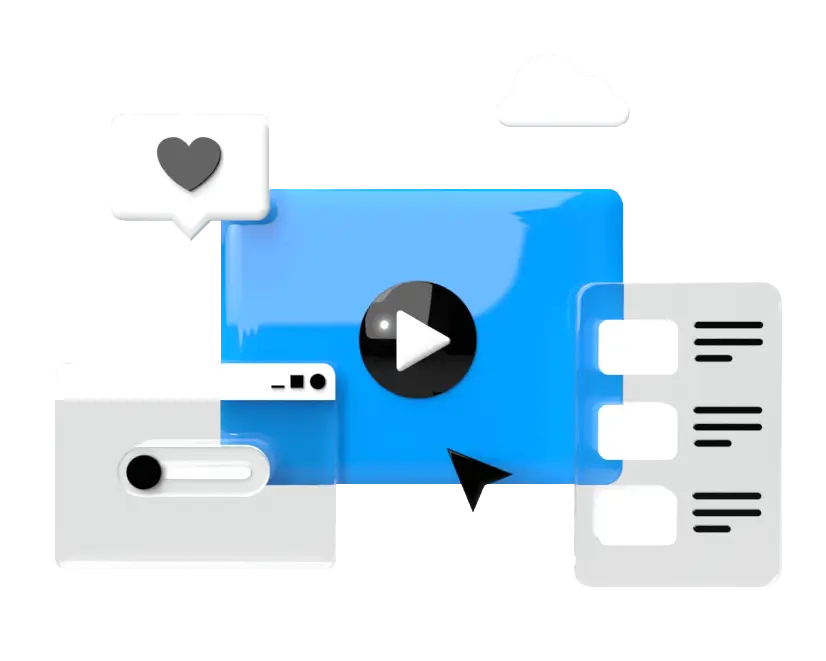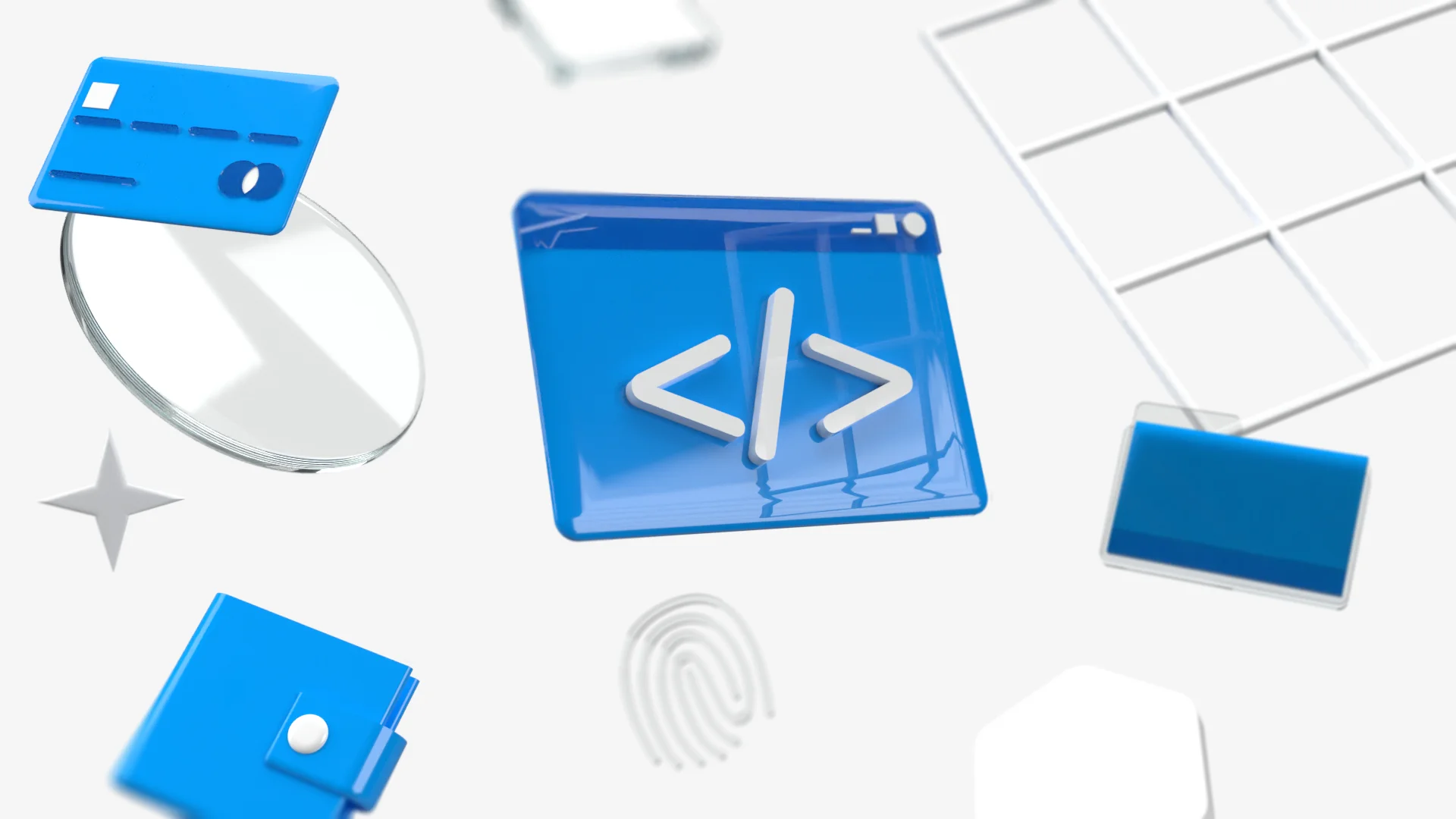What Is Digital Transformation: Challenges, Innovation, and Culture of Change
02.11.2023
In a world where technology advances unprecedentedly, businesses must adapt to remain competitive and relevant. Digital transformation is the key to unlocking this adaptability. It encompasses many complex components, all with one overarching goal: to reshape how organizations operate and deliver value.

In this article, we will try to provide a guiding light for businesses undertaking their digital transformation journey. We will also delve into the complexities of this transformative process, exploring its importance, benefits, common challenges, evaluation metrics, and key leadership roles. But first things first…
What Is Digital Transformation in Simple Words?
Digital transformation is a complex concept that can be divided into different components:
- The process of integrating digital technologies into various aspects of an organization’s operations and strategies, which dramatically changes the company’s operation principles.
- The cultural change that creates new motivation and new objectives for the company.
- The fundamental change in how it delivers value to customers, employees, and stakeholders.
In other words, this is a strategic shift that goes beyond the simple adoption of new technologies and requires a comprehensive reassessment and rethinking of the organization’s core functions and operations.
Some stats
In general, the main goal of digital transformation is to create a severe competitive advantage through large-scale and continuous adoption of technologies. It also aims to improve customer interaction and reduce costs, including operational ones.
Prerequisites of digital changes
Digital technologies have always influenced business in various areas, but in the last decade, the need for transformation has increased significantly. This is due to the challenges of the recent COVID-19 pandemic, which has significantly accelerated the pace of change in organizations worldwide. It will also be facilitated by the need for organizations to be on par with competitors, to become more flexible in responding to changing markets, and to be more sustainable through innovation.
Prophet’s analysis shows that the main driving force behind digital transformation is market pressure and the new challenges of data security. According to their data, more than half (51%) of efforts arise from new growth opportunities, and 41% are influenced by increased competitive pressure.
Experts also say that this process is becoming more widespread due to companies’ concerns about data security. High-profile cases of data leaks and new regulatory standards for their prevention (such as GDPR) are the reasons for 38% of organizations to transform.
Some numbers
According to Markets and Markets research, the digital transformation market is expected to reach $3.144 billion with a CAGR of 24.1%.
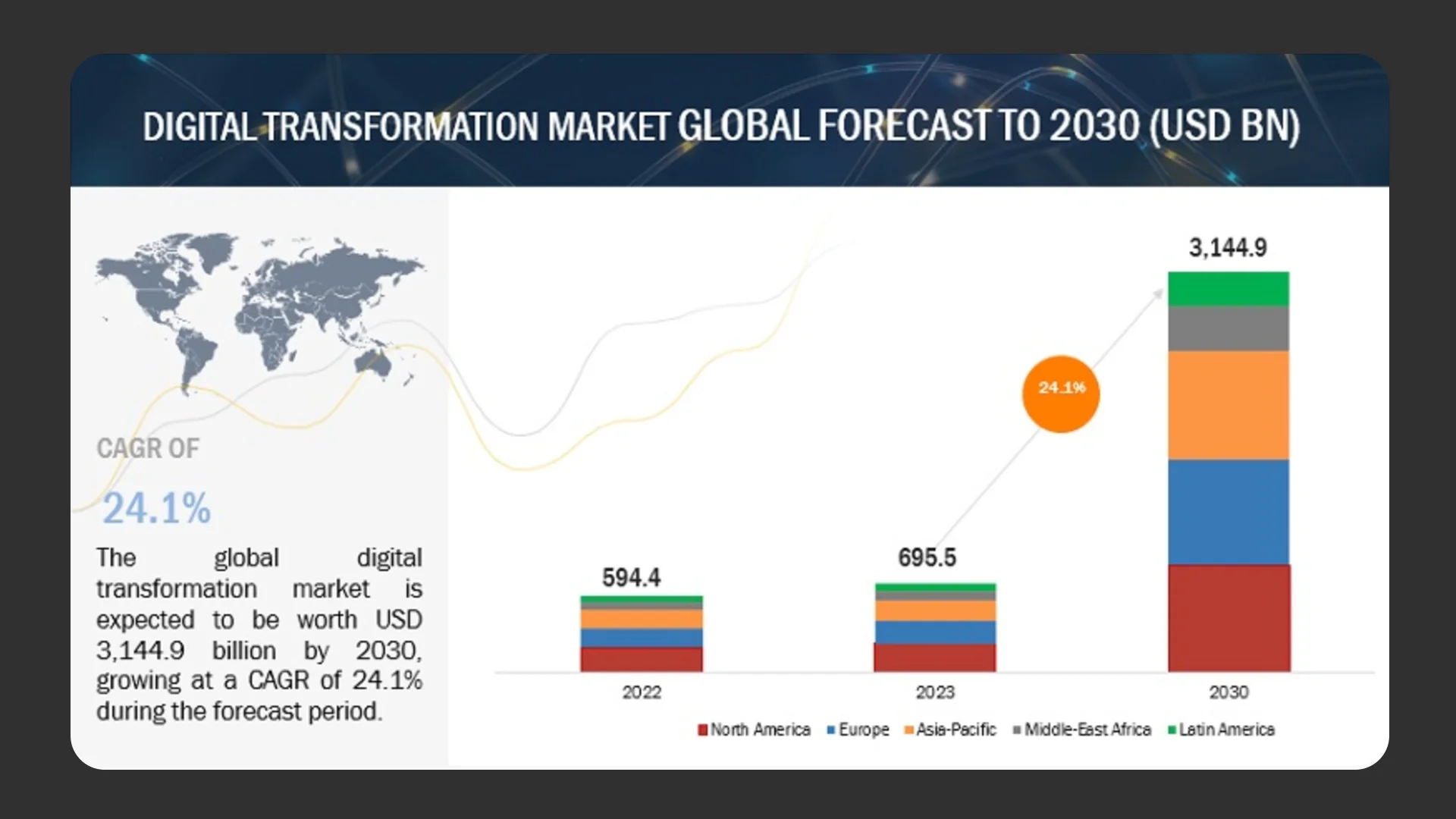
Source: Markets and Markets
Also, by 2023, digitally transformed organizations are expected to account for more than half of GDP, or $53.3 trillion. According to Statista forecasts, by 2026, global spending on digital transformation will reach $3.4 trillion.

Source: Statista
Digital transformation approaches
Statista’s research shows that in 2022, the most common approaches to solving companies’ digital transformation strategies were reusing and repurposing existing solutions with traditional infrastructure and cloud extensions for existing solutions. 45% of the respondents’ organizations focused on the modernization of the existing capacity or chose a mixed approach. 15% of respondents preferred development from scratch.
Digital transformation is about a broad cultural shift to more flexible and intelligent business methods. This applies to all business areas, starting with the application of Artificial Intelligence (AI), big data, and cloud computing for industry and ending with the implementation of specialized robotics for manufacturing. Nearly three-quarters of global organizations named this process their top IT priority in 2022, compared to only half in 2021.
Digital Transformation and Business Transformation: What Is the Difference?
Adapting to fast-moving changes is critical for any business to not only compete but even survive. Understanding the direction and strategy of digital change also requires focusing all efforts around a specific program.
Digital transformation differs from business transformation in several critical ways.
- The endpoint of BT is the achievement of a new model of behavior. In the case of digital change, we are talking about a constant and continuous effort to improve and adapt the company. It’s about the long-term perspective of scaling.
- Business transformation is not tied to the adoption of technologies, while digital is about the integration of technologies that are constantly developing, and together with them, the business is dynamically changing.
In both cases, company leaders and C-Suit play a prominent role. However, the success of digital transformation depends not so much on how organizations can use digital solutions but on how they become digital and flexible themselves.

Benefits of Digital Transformation
Digital transformation is a strategic necessity and competitive edge for businesses aiming to be successful in a rapidly evolving landscape. This paradigm shift offers a wide array of benefits, both tangible and intangible. Let’s take a closer look at them.

- Better efficiency and productivity. Digital transformation streamlines manual processes through automation, which can significantly boost efficiency. Tasks that once took hours or days can now be completed in mere minutes. It not only saves time but also reduces the margin for error, leading to increased productivity.
- Sustainability and scalability. Many digital transformation initiatives include eco-friendly practices. Going paperless, optimizing energy use, and reducing waste not only contribute to a greener planet but also often result in cost savings. As businesses grow, digital transformation solutions can easily scale to accommodate increased demand. This scalability ensures that your systems remain responsive and efficient as your customer base expands.
- Greater accessibility and reach. Cloud computing, AI technologies, and other digital technologies help businesses operate and serve customers from virtually anywhere. This opens up new markets and customer segments, increasing accessibility and reach.
- Agility and innovation. As we said before, digital transformation encourages a culture of innovation. Businesses can quickly adapt to changing market conditions and customer demands. This adaptability fosters a more agile and innovative environment.
- Data-driven decision-making. Access to real-time data and analytics empowers businesses to make informed decisions. It leads to proactive problem-solving, strategic planning, and better forecasting, reducing risks and increasing profitability.
- Enhanced security. Adopting new digital solutions is also a way to eliminate the old shortcomings of the security system. It often involves robust cybersecurity measures to protect valuable data. This, in turn, safeguards your business from threats and cyberattacks.
- Improved customer experience. Thanks to digital transformation, you will be able to understand your customers more deeply. You can tailor products and services to their specific needs using data analytics and customer insights. This level of personalization leads to increased customer satisfaction and loyalty.
Last but not least, digital transformation is a perfect way to invest in a company’s future and save costs by reducing manual processes, optimizing operations, and making data-driven decisions. This may include lower operational costs, reduced errors, and better resource allocation.
The benefits extend beyond the balance sheet, influencing your brand, customer relations, and overall market presence. It’s not a matter of ‘if’ but ‘when’ your business should embark on this digital transformational journey.
What Are the 5 Pillars of Successful Digital Transformation?
Successful digital transformation of any business is a series of clear and coordinated actions. The preparation process is as necessary as the changes themselves. So, let’s talk about what you should pay attention to first.
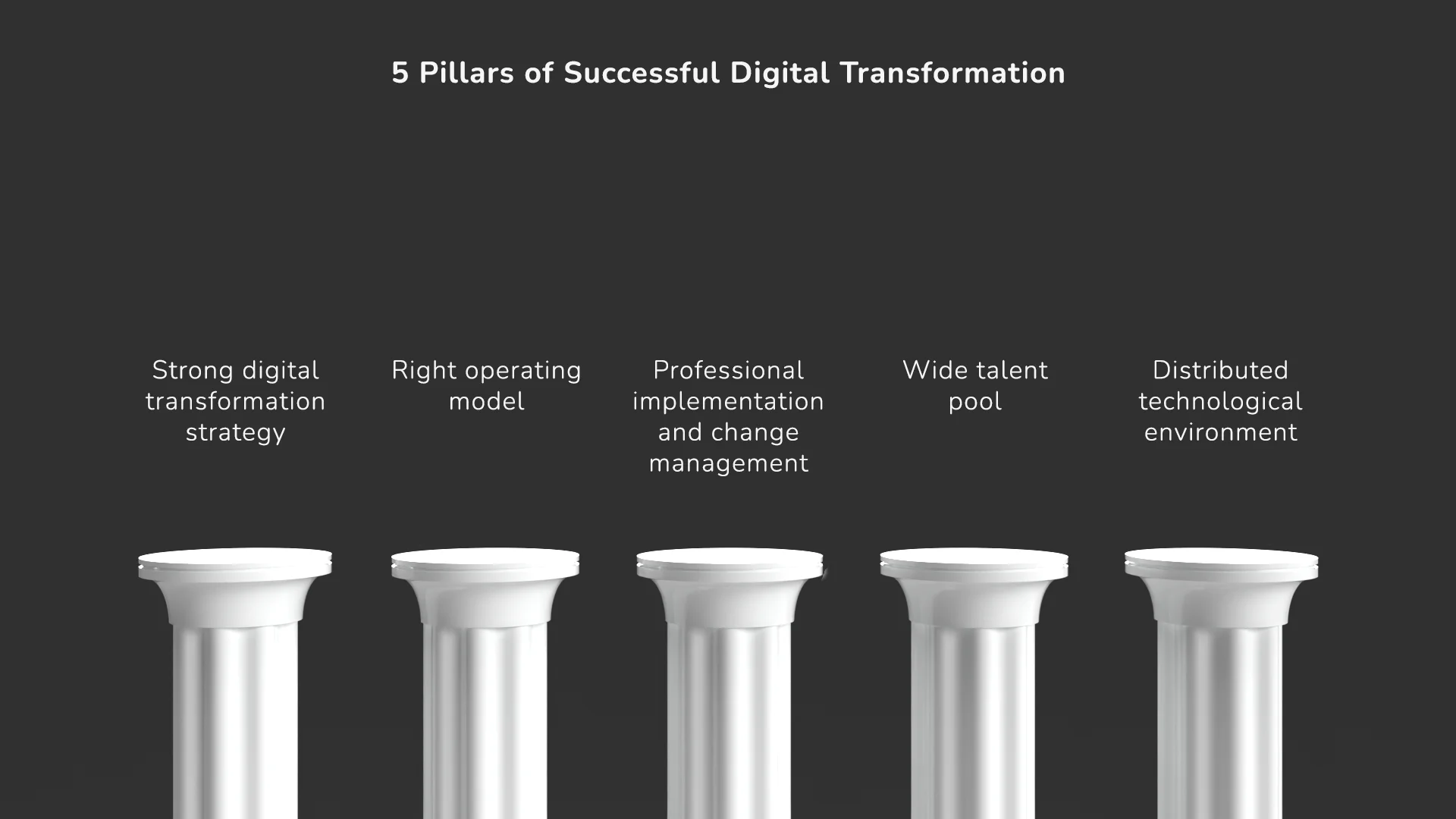
Creating the right digital transformation strategy
Your strategy should not only be thought out in detail and based on analytical data but should also support your business value. Focus your transformation around specific points, such as features, business processes automation, or customer journeys, that create significant value for the business.
In addition, all changes should take place according to a clear roadmap (we will talk about it in the following articles). In short, this document describes the solutions and resources needed to implement changes in priority areas. And digital transformation strategy clarifies it.
Preparation of the operating model
It is worth understanding that implementing new technologies requires the support of a large number of departments and teams, so it is worth preparing for this. Operating models are frameworks or strategies that organizations can adopt to drive their digital transformation initiatives. We will focus on three main options – the digital factory, the product and platform model, and the enterprise-wide agility model.
Digital Factory Model
The digital factory model, also known as the digital innovation factory, is a centralized approach to digital transformation.
In this case, organizations establish a dedicated unit or team responsible for generating and implementing digital initiatives.
This unit operates separately from traditional business operations and focuses on rapid prototyping, experimentation, and innovation.
Key characteristics:
- Innovation hub. The digital factory serves as an innovation hub, fostering a culture of experimentation and agility.
- Quick iterations. Projects are executed in short cycles with the goal of delivering incremental improvements.
- Cross-functional teams. Multi-disciplinary teams collaborate to generate and implement digital solutions.
Benefits:
- Speed to market. Rapid development and deployment of digital products or solutions.
- Innovation focus. A dedicated unit drives innovation and minimizes disruption to core business operations.
- Risk mitigation. Failures are embraced as part of the innovation process, allowing organizations to learn and adapt quickly.
Enterprise-Wide Agility Model
The enterprise-wide agility model is a holistic approach to digital transformation.
It seeks to infuse agility and adaptability throughout the entire organization.
Agility becomes a core part of the organizational culture, and various departments collaborate to drive change.
Key characteristics:
- Agile culture. The organization fosters an agile culture that encourages innovation and adaptation.
- Cross-functional collaboration. Various teams and departments work together to enable change.
- Continuous improvement. Agile principles, such as iterative development and feedback loops, are embraced.
Benefits:
- Organizational flexibility. The entire organization becomes adaptable and responsive to change.
- Innovation at scale. Agility allows for continuous innovation across all business functions
- Employee engagement. Employees are empowered and motivated to contribute to digital transformation.
Product and Platform Model
In the product and platform model, organizations shift from project-based to product-based thinking.
They develop digital products or platforms that cater to customer needs.
These products are continuously improved, and the focus is on building long-term digital capabilities.
Key characteristics:
- Product mindset. Digital solutions are treated as products with continuous lifecycles.
- Customer-centric. Development efforts prioritize meeting customer needs and demands.
- The model emphasizes scalability, with platforms serving as the foundation for multiple solutions.
Benefits:
- Customer satisfaction. Focus on customer needs leads to enhanced customer experiences.
- Sustainability. Digital products or platforms can evolve over time to remain relevant.
- Efficiency. Scalability allows for the reuse of core components and faster development cycles.
These operating models offer different approaches to digital change. Organizations often choose the model that aligns best with their goals, culture, and industry and may even blend elements from multiple models to suit their specific needs.
The key to success in digital transformation is selecting a model that suits the organization's unique context and challenges. And we know how to do this. Just contact us now, and let’s start your digital transformation journey to success!
Professional implementation and change management
While the traditional cycle of digital change consists of a gradual transition from one step to another (gathering of requirements – development of solutions – testing, etc.), a more successful and sufficient approach should be more iterative. This involves deep research, designing, prototyping, gathering and processing feedback, and based on this, improving the solution so that it can fully exploit its value potential.
It is critical to consider how you will manage adoption and scale early in your transformation. This way, you can allocate the resources you need to make the change happen. And if you do not have such experience, it is definitely worth contacting specialists.
Creating a wide talent pool for digital change
As we have already said, successful digital transformation is not about adopting digital but about becoming digital. Therefore, you need to have a talent pool that will work on a constant process of change.
You can search for such a team yourself. In this case, you will have to take care of value propositions for employees, flexible and efficient HR processes for sourcing, as well as talent management and training.
You can also hire a ready-made cohesive team that will become a dedicated partner of your business. This option will help save time and resources. Don't know where to find such specialists? Contact us for consultation.
Creating a distributed technological environment and full data access
is necessary so teams can independently implement innovations. Each team must have access to the required data, development tools, etc. You can use cloud capabilities to migrate workloads, integrate APIs, and so on.
Reliable current data is a vital part of a smooth and successful digital transformation. That’s why data architecture is everything. Before starting the change process, it is worth considering the constant analysis and updating of data, ensuring access to them, management, and protection.
Key Leadership Roles in a Digital Transformation
Digital transformation is a monumental undertaking that reshapes how organizations adapt in a rapidly changing landscape. It requires a multi-faceted approach with strong leadership to ensure alignment, accountability, and sustained progress. In this context, several key roles are vital in steering an organization through a successful digital change.
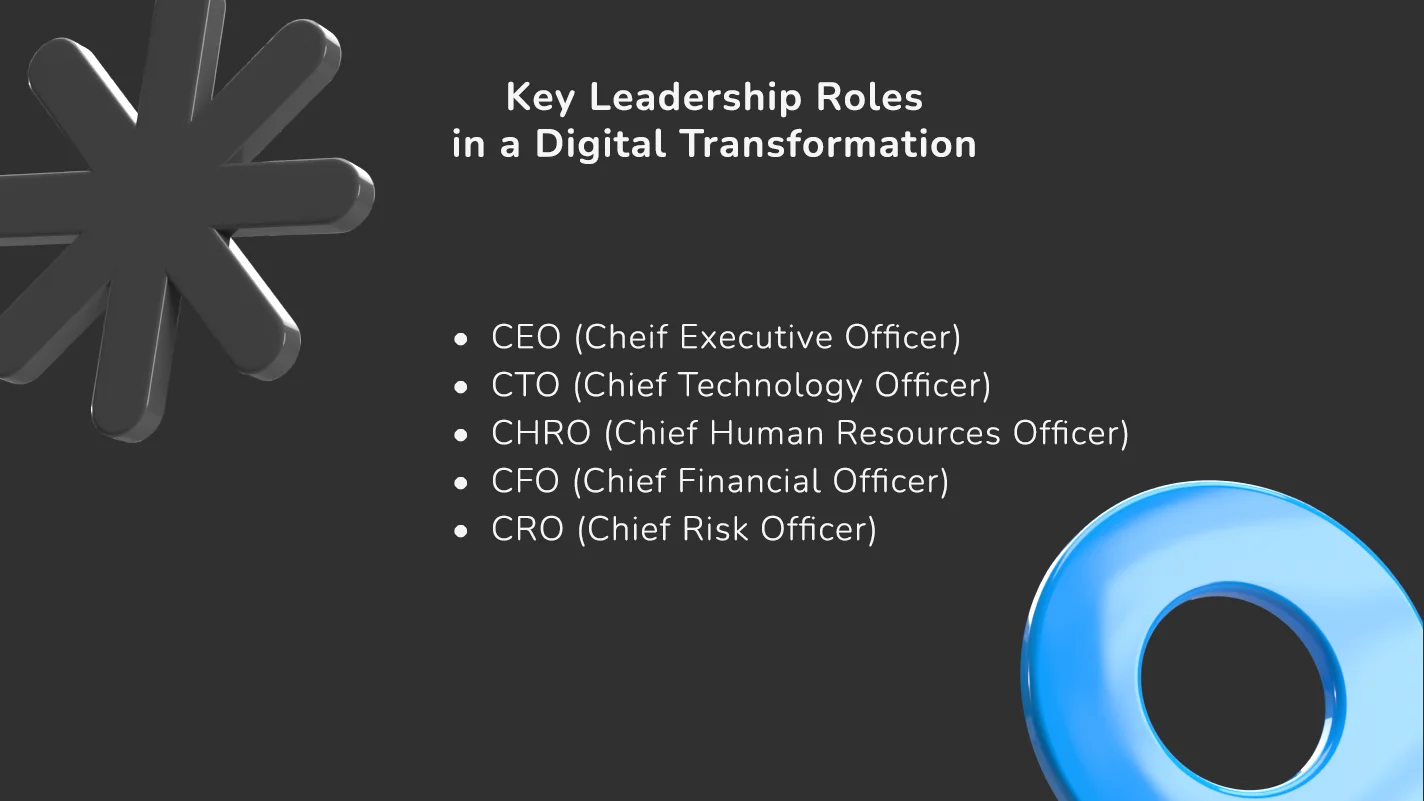
CEO: the visionary leader
CEO is at the epicenter of a digital transformation. This is a visionary leader responsible for defining the transformation’s strategic direction. The CEO sets the tone for the entire organization and must champion the cause of digital transformation, driving alignment, commitment, and accountability among the leadership team.
The CEO’s unwavering commitment to this change initiative is crucial, as it instills confidence in stakeholders, inspires employees, and ensures the long-term focus required for such a significant undertaking.
C-Suite leaders: orchestrators of transformation
Leaders within the C-suite are the driving forces that bring the digital transformation strategy to life. Here are some key roles within this leadership tier:
- CIO (Chief Information Officer). The CIO focuses on improving the organization’s internal operations by harnessing technology. Their role is to ensure that the technology infrastructure is robust and capable of supporting digital initiatives. This includes optimizing business processes, data management, and IT systems for increased efficiency and effectiveness.
- CTO (Chief Technology Officer). The CTO concentrates on enhancing customer offerings through technology. This involves leveraging technology to create innovative products and services that meet evolving customer needs. They are pivotal in driving digital innovation that directly impacts customers’ experiences.
- CHRO (Chief Human Resources Officer). The CHRO plays a crucial role early in the transformation by securing digital talent. This includes identifying, attracting, and retaining individuals with the skills and expertise needed for digital success.
- CFO (Chief Financial Officer). The CFO oversees the transformation’s business case and the tracking of value realization. They are responsible for ensuring that the investments made in the transformation yield the expected returns and that the financial aspects of the initiative align with the organization’s strategic objectives.
- CRO (Chief Risk Officer). The CRO is tasked with directing the integration of risk management practices into the development process. In a digital transformation context, this involves understanding, assessing, and mitigating new risks. They ensure that the transformation proceeds with a keen awareness of potential risks and their implications.
These key leadership roles work in tandem to steer the organization toward its digital transformation objectives. Their collaboration, expertise, and dedication are pivotal in navigating the complexities of digital change.
Common Challenges With Digital Transformation
Digital transformations can fail for many reasons. Despite their efforts, most companies have the most challenges with digitizing data. Also, statistics show that in 46% of cases, legacy technologies/technical debt limited their organizational strategy, and 56% of companies are unsure about the risks.
Let’s take a look at other challenges.
Budget constraints
One of the most common limitations in the digital transformation journey is budget constraints. Organizations often struggle with allocating the necessary financial resources to implement large-scale technological changes. To overcome this challenge, companies can take several steps.
First, it’s crucial to create a clear and comprehensive digital transformation strategy that outlines the specific financial needs of the initiative. Additionally, businesses can explore cost-effective solutions, prioritize projects based on their potential return on investment, and seek external funding or partnerships to support transformation efforts.
Employee resistance to change
Change can met with resistance, and employee buy-in is crucial for the success of any digital transformation. Overcoming resistance starts with effective communication and education. Organizations should communicate the reasons for the transformation, its benefits, and how it aligns with the company’s vision and mission.
Providing training and resources to employees, making them part of the decision-making process, and recognizing and rewarding those who embrace change can also help mitigate resistance.
Integration issues
Integration challenges arise when existing systems and new technologies need to work together seamlessly. These issues can slow down the transformation process and disrupt operations. Businesses should thoroughly assess their current technology stack and infrastructure to tackle integration challenges.
They can then prioritize integration efforts, invest in interoperable systems and APIs, and consider leveraging middleware solutions. It’s essential to work closely with IT experts to ensure a smooth integration process.
Cybersecurity concerns
With the increasing reliance on digital technologies, cybersecurity is a paramount concern. Data breaches and cyber threats can have devastating consequences for organizations.
Overcoming cybersecurity concerns involves a proactive and multi-faceted approach. This includes
- implementing robust cybersecurity measures;
- conducting regular risk assessments;
- providing cybersecurity training to employees;
- staying updated on the latest security threats and best practices.
Collaboration with cybersecurity experts and the use of advanced tools and technologies are also essential to safeguard digital transformation efforts.
Addressing these common challenges with a well-defined strategy and proactive measures is critical. Only in this way can organizations navigate the complexities of digital transformation more effectively and increase their chances of achieving successful outcomes.
Evaluating the success of a digital transformation
Evaluating the effectiveness of a digital transformation initiative can often pose a significant challenge. It requires meticulous monitoring and measurement to ensure that the team implements changes genuinely, creates value, and drives progress.
Understanding what to measure is a fundamental aspect of this process is essential. Let’s take a look at the main metrics to consider.
Firstly, you need to keep in mind the value creation. Digital solutions generally aim to improve one or several operational key performance indicators (KPIs), which can often be directly linked to financial gains and overall value addition.
The second point is progress in change. The team must assess the efforts in building new capabilities and the overall health of the transformation effort. It gives the answers to questions like:
- Were the teams prepared as planned?
- Are employees actively engaged in the process?
- Are the development of capabilities and talents on track?
Also, you should remember about your working environment and team health. The pace of many digital transformations can be impeded by factors like reluctance to embrace contemporary methodologies like Agile or the absence of critical competencies such as product management and user-experience design.
The Bottom Line
Digital transformation is a beacon of innovation and adaptation. It’s not a matter of ‘if’ businesses should embark on this journey, but rather ‘when.’ Changes are imperative to every business’s success. They catalyze improved efficiency, sustainability, agility, and innovation.
We encourage you to embrace this paradigm shift, break free from traditional constraints, and explore the boundless opportunities offered by the digital age. The future belongs to those who can adapt and bring business value, and digital transformation is your vehicle to get there.
If you don’t know how to start your transformation journey or need guidance on this path, feel free to contact us for expert consultation and assistance. Your digital future awaits, and we are here to guide you every step of the way.
